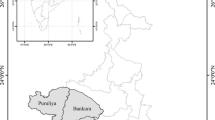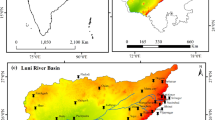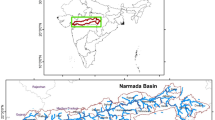Abstract
Drought is one of the most complicated and least explored amongst weather related natural disasters, affecting large population in the world. Its analysis is highly significant in water resources planning and management. Drought may be identified as of various types, among which, Meteorological drought is considered for our study view point. Many indices are in use for characterization of meteorological drought, among which Standardized Precipitation Index commonly known as SPI is popularly used and adopted by World Meteorological Organization also as standard drought index. In our study, SPIs were applied at variable 3, 6 and 12 months time scales, using monthly precipitation record obtained from four different rain gauge stations situated within the basin, for the time duration of around 20 years to assess both short and long-term droughts. The analysis of time series plots of SPIs indicated history of drought at all the four rain gauge stations of the Chaliyar basin. Hence, the outcomes from this study can be used by water managers and policy makers for Drought management and implementation of sustainable water resources schemes.
Access provided by Autonomous University of Puebla. Download chapter PDF
Similar content being viewed by others
Keywords
- Drought
- Meteorological drought
- Standardized Precipitation Index (SPI)
- Chaliyar basin
- Time series plots of SPIs on multiple time scale
- Sustainable water resources planning
1 Introduction
Drought is weather related natural calamity. The popular explanation considers drought as considerable decline in water availability over a vast area for a long duration of time. In fact, drought is one of the most complicated and less explored amongst all natural disasters, having its negative influence over a large section of Human Population (Wilhite 2000).
Because of slow development of a drought, people often are not aware of the emergence of droughts in time. Hence, more insights in the development of drought can help the people to be aware of drought at initial stages.
Drought usually initiates with precipitation deficit, but affects ground water, soil moisture, streamflow, ecosystem and even human beings also, in further stages resulting in identification of numerous types such as Hydrological, meteorological, agricultural, socio-economic and physiological droughts etc. Each of these types reflects perspectives of various sectors on water shortages (Wilhite and Glantz 1985). Among all these kinds of droughts, only Meteorological drought has importance for our study, which is primarily induced by deficit in precipitation and may have large scale influence over various components of basin ecosystem.
2 Study Area
The Study Area is Chaliyar river basin, Kerala, India, that falls between 11° 30′ N and 11° 10′ N latitudes and 75° 50′ E and 76° 30′ E longitudes. Chaliyar is the 3rd largest river in Kerala. It originates from Elambalari Hills of Nilgiri District in Tamil Nadu, having an average elevation of about 2066 m above mean sea level (MSL). This river is an all season perennial stream, which covers a distance of around 169 km before joining Lakshadweep Sea at Beypore near Kozhikode.
The approximate area drained by the river is 2918 km2, out of which 2530 km2 lies in Kerala and the remaining area lies in the state of Tamil Nadu. The drainage Map for our study area is shown by Fig. 10.1. (Ansari et al. 2020).
3 Materials and Methods
3.1 Description of Data Used
The data was collected from CWRDM, Kerala for ten rain gauge stations situated within the basin (Table 10.1). This information was provided by various agencies to the CWRDM. The duration of data provided is very small for few stations and infact large data series length is missing for many other stations. Hence, Monthly Rainfall Data for only 4 stations of Ambalavayal, Kalladi, Manjeri, and Nilambur for the duration of 1993–2012 was used.
3.2 Drought Characterization
For characterization and statistical analysis of Drought, drought indices are commonly used. These indices transforms present situation in historical context and provide temporal-spatial representations for drought history in a region (Akhtar et al. 2021). Analysis of Drought with respect to stochastic view point provides information necessary for subsequent risk analysis i.e. probabilities of drought occurrence and drought impacts.
To carry out measurement of meteorological dryness, many indices are used. Among them, popular indices are ‘simple rainfall deviation from historical norms’, ‘palmer drought severity index’ and ‘standardized precipitation index’ etc. (Kumar et al. 2011). Out of the above, SPI has become popular in recent years, as it is easy, versatile and efficient technique for analysing drought climatology (Hughes and Saunders 2002).
3.3 Standardized Precipitation Index (SPI)
Standard Precipitation Index chiefly designed as a technique for Drought analysis, monitoring and description. This was introduced by T.B. Mckee, N.J. Doesken and J. Kleist, Colorado State University, 1993.
This index shows much potential, as it is flexible, versatile, powerful and easy to estimate (McKee et al. 1993), infact only precipitation needed as input parameter. The probability of observed precipitation is converted to this index, known as SPI. The basis for developing this parameter is to enumerate deficit in precipitation on numerous timescales (Chahal et al. 2021). Using the rainfall records for long term, computation of this index for desired location and desired period can be carried out. For this analysis, the initial step is to fit long duration rainfall records to probability distribution and thereafter transformation to normal distribution takes place, which gives average SPI value for period and location as zero (Edwards and McKee 1997).
+ ve SPI values designate ˃ median precipitation whereas − ve values designate ˂ median precipitation.
Generally, SPI computation is carried out on 3, 6, 12, 24 and 48 months, timescale. These timescales indicates Drought’s impact on various components of Hydrological cycle (Sappa et al. 2019).The significance of SPI on multiple time scale is given in Table 10.2.
3.4 SPI Computation Algorithm
The development of algorithm for SPI computation is based on following rationale. The initial step for Computation of SPI is to find out the probability density function optimally describing precipitation-data distribution on various scales of time (Guttman 1998). This pattern is separately applied for each month. Using the L-moments ratios diagrams, suitable distribution function was chosen (Hosking and Wallis 1997). Thereafter, gamma probability density function with 2 parameters was used and the maximum likelihood approach was applied to quantify the pertinent parameters. Thereafter, variable scales of time i.e. 1 month, 3 months, 6 months, 12 months and 24 months are selected for index calculation, representing random scales of time for deficits in precipitation related to SPI application. Every Information set is applied to gamma probability density function having scale parameter β and shape parameter α, so as to define relation between precipitation and probability. Gamma-cumulative-distribution-function get transformed in to standardize normal-cumulative-distribution-function having equal-probability transformation, accompanying a mean and standard deviation of zero and unity respectively. The above standardization offers the benefit of possessing persistent values in space and time for cycle of extremely dry and wet event (Karavitis et al. 2011).
To be very explicit, the computation of SPI can be performed by fitting probability density function in to precipitation frequency distribution summed for desirable scale of time which carried out exclusively for different months and locations of space. Thereafter, transformation of every probability density function to standardized normal distribution takes place i.e. for calculation of SPI, on every time scale, precipitation totals variability, initially defined as gamma distribution, later on transformed in to normal distribution (Abeysingha nd Rajapaksha 2020).
The gamma distribution defined by its probability density function is as follows (Mishra and Desai 2005):
where, α(shape parameter) > zero, β (scale parameter) > zero, x(precipitation amount) > zero.
Γ(α) (gamma function)is denoted as:
For fitting, distribution to data, α and β should be known. A method was recommended by Edwards and McKee (1997) for estimation of above parameters using the theory provided by Thom (1958) regarding optimum likelihood:
- n:
-
number of observation
Resultant parameters will be utilized for computing cumulative-probability for an observed precipitation event of given month or some alternative scale of time (Mishra and Desai 2005).
Since gamma function is not defined for x = zero and precipitation distribution could consist of zeros, cumulative probability H(x) is calculated from the given equation (Abeysingha and Rajapaksha 2020):
Here q = probability of zero precipitation and G(x) = cumulative probability of the incomplete gamma function.
H(x), cumulative probability, thereafter, transformed to standard normal random variable Z (accompanying mean as 0 and variance as 1), that finally will give the value of SPI (Mishra and Desai 2005).
Above mentioned algorithm, although simple, is not practically suitable for SPI computation in case of large number of Data points. Hence following Edwards and McKee (1997), Hughes and Saunders (2002), other methods for approximate conversions are in practice. In this paper, we will use a program for the calculation of SPI on different time scales and the methodology followed for carrying out research work is shown in Fig. 10.2 with the help of a flowchart.
In the present paper, monthly precipitation data for 4 rain gauge stations located within Chaliyar basin were utilized to compute SPI values at timescales of 3, 6 and 12 months for the period 1993–2012.
4 Results and Discussion
The standardized precipitation index exhibits a statistical Z-score or number of standard deviations (Edwards and McKee 1997). It is used in our analysis to estimate monthly precipitation deficit anomalies over different scales of time. In present paper, its estimation on numerous scales of time i.e. 3, 6 and 12 months have been carried out. Agricultural and Meteorological droughts impacting precipitation and soil moisture respectively, are generally related to short term time scales of 3 and 6 months SPIs whereas long term time scale i.e. 12 month SPI or more are related with hydrological droughts impacting stream flow and reservoir levels (Khan et al. 2018).
If we plot variation of time series of the years against SPI for any station, it provides fair reflection of drought history for that station. Accordingly time series plots of SPI on time scale of 3, 6 and 12 months for Ambalavayal, Kalladi, Manjeri and Nilambur are given as Figs. 10.3, 10.4, 10.5 and 10.6 respectively. Estimated SPI values (Z-score) distribute precipitation events for specified time duration amongst excess (Heavy precipitation), normal and low (deficits precipitation). Z score value i.e. Z > 2.0 shows extremely wet events/weather over the particular scale of time. The SPI value between 1.5 and 1.99 indicate the very wet event and the moderately wet event is represented by values between 1.0 and 1.49. SPI value lying between 0.99 > z > -0.99 denotes normal precipitation event. Moreover, − 1 > z > − 1.49 indicate moderately drought events. If Z score value falls between − 1.99 < z < − 1.5, it indicates severe drought condition and when Z score goes below − 2, it indicates extreme drought condition.
After plotting the above SPIs time series curves on multiple timescales for different stations within the basin, we perform the Drought Characterization in Microsoft Excel for the same stations based on the SPI values interval. Accordingly, multiple Moderate, Severe and Extreme Drought events are reported for all the four stations on different timescales. The intensity of Drought events decreases from Moderate to Extreme Drought i.e. higher numbers of Moderate Drought events are reported as compare to severe and extreme. Although, the intensity of Extreme Drought events is least, but still those can’t be neglected, as those are the events of serious concern. Noticeable Severe Drought events are also reported.
The Drought Characterization for Nilambur, Kalladi, Manjeri and Ambalavayal for the time duration of 20 years (1993–2012) is shown below with the help of Tables 10.3, 10.4, 10.5 and 10.6 respectively.
5 Conclusion
Drought analysis was performed using Standardized Precipitation Index (SPI) on both long-term as well as short-term time scales at all the four rain gauge stations (Ambalavayal, Kalladi, Manjeri and Nilambur) of Chaliyar river basin. Analysis of time series plots for all stations on different time scales shows fluctuations representing wide range of weather events ranging from extremely drought to extremely wet events. Drought Characterization at all the four stations reveals history of Moderate, Severe as well as Extreme Drought Events. Periodical re-occurrence of drought and wet periods was also observed.
In today’s world of Climate change, these repeated Drought events are of grave concern. Sustainable Development Goal 15 of the 2030 Agenda talks about Desertification, Land Degradation and Drought, however, recent COVID 19 Pandemic has aggravated the situation; especially poor’s are worse affected.
Although, more scope of research is still there, but it can be concluded that multi scope Standardized Precipitation Index has efficiently characterized the Drought in the Chaliyar basin as all the four rain gauge stations were found to affected by meteorological drought in near history, when analyzed using SPI. This study may also be utilized for preparation of drought mitigation plan by water resources development planners, scientists and engineers ensuring sustainable water resource planning and drought management for the basin.
Last but not the least, it is suggested that, this Natural Hazard needs to be explored furthermore. More awareness amongst the society is still needed and more participation of stakeholders should be promoted to address this grave issue.
References
Abeysingha NS, Rajapaksha URLN (2020) SPI-based spatiotemporal drought over Sri Lanka. Adv Meteorol 2020:10
Akhtar MP, Faroque FA, Roy LB, Rizwanullah M, Didwania M (2021) Computational analysis for rainfall characterization and drought vulnerability in Peninsular India. Math Probl Eng 2021:1–27
Ansari, MI, Thakural LN, AnbuKumar S (2020) Streamflow modelling for a peninsular Basin in India. In Ahmed S et al (eds) Smart cities-opportunities and challenges. Lecture notes in civil engineering, vol 58, pp 645–659
Chahal M, Singh O, Bhardwaj P, Ganapuram S (2021) Exploring spatial and temporal drought over the semi‑arid Sahibi river basin in Rajasthan, India. Environ Monit Assess 193:743
CWRDM: Centre for Water Resources Development and Management, Kozhikode, Kerala, India
Edwards DC, Mckee TB (1997) Characteristics of 20th century drought in the United States at multiple time scales. Atmos Sci Pap 634:1–30
Guttman NB (1998) Comparing the palmer drought index and standardized precipitation index. J Am Water Resour Assoc 34(1):113–121
Hosking JRM, Wallis JR (1997) Regional frequency analysis: an approach based on L-moments. Cambridge University Press, Cambridge, UK
Hughes BL, Saunders MA (2002) A drought climatology for Europe. Int J Climatol 22:1571–1592
Karavitis CA, Alexandris S, Tsesmelis DE, Athanasopoulos G (2011) Application of the standardized precipitation index (SPI) in Greece. Water 3:787–805
Khan MMH, Muhammad NS, Shafie AE (2018) A review of fundamental drought concepts, impacts and analyses of indices in Asian continent. J Urban Environ Eng 12:106–119
Kumar MN, Murthy CS, Seshasai MVR, Roy PS (2011) Spatiotemporal analysis of meteorological drought variability in the Indian region using standardized precipitation index. Meteorol Appl 19:256–264
Latha A, Vasudevan M. (2016) Kerala report: State of India’s Rivers for India River Week-Kerala
Mckee TB, Doesken NJ, Kliest J (1993) The relationship of drought frequency and duration to time scales. In: Proceedings of the 8th conference on applied climatology, 17–22 January, Anaheim, CA. American Meteorological Society, Boston, MA, USA, pp 179–184
Mishra AK, Desai VR (2005) Spatial and temporal drought analysis in the Kansabati river basin, India. Int J River Basin Manag 3(1):31–41
Sappa G, Filippi FMD, Lacurto S, Grelle G (2019) Evaluation of minimum Karst spring discharge using a simple rainfall-input model: the case study of Capodacqua di Spigno Spring (Central Italy). Water 11:807
SPI Map Interpretation, National Drought Mitigation Center, University of Nebraska-Lincoln. Available from https://drought.unl.edu/droughtmonitoring/SPI/MapInterpretation.aspx
Thom HCS (1958) A note on the gamma distribution. Mon Weather Rev 86:117–122
Wilhite DA (2000) Chapter 1: drought as a natural hazard: concepts and definitions. In: Wilhite DA (ed) Drought: a global assessment. Routledge, pp 3–18
Wilhite DA, Glantz MH (1985) Understanding the drought phenomenon: the role of definitions. WaterInternational 10:111–120
Author information
Authors and Affiliations
Corresponding author
Editor information
Editors and Affiliations
Rights and permissions
Copyright information
© 2022 The Author(s), under exclusive license to Springer Nature Switzerland AG
About this chapter
Cite this chapter
Ansari, M.I., Thakural, L.N., Hassan, Q., Alam, M. (2022). Study of Meteorological Drought Using Standardized Precipitation Index in Chaliyar River Basin, Southwest India. In: Yadav, B., Mohanty, M.P., Pandey, A., Singh, V.P., Singh, R.D. (eds) Sustainability of Water Resources. Water Science and Technology Library, vol 116. Springer, Cham. https://doi.org/10.1007/978-3-031-13467-8_10
Download citation
DOI: https://doi.org/10.1007/978-3-031-13467-8_10
Published:
Publisher Name: Springer, Cham
Print ISBN: 978-3-031-13466-1
Online ISBN: 978-3-031-13467-8
eBook Packages: Earth and Environmental ScienceEarth and Environmental Science (R0)










